[ad_1]
Evidence Based
The sissy squat is a quad exercise that’s hit it big of late.
Its stock has soared because it trains all the muscles in your quads in a fully lengthened position—something most other quad exercises, including the back and front squat, don’t. And this means it’s uniquely effective for rounding out your quad development.
In this article, you’ll learn what the sissy squat is, its benefits, which muscles it works, how to do it with proper form, the best sissy squat alternatives, and more.
What Is a Sissy Squat?
The sissy squat is a bodyweight exercise that primarily trains the quadriceps.
Typically, you perform the sissy squat by holding onto something sturdy, then flexing your glutes and bending your knees, allowing your body to lean backward, your knees to track over your toes, and your heels to come off the ground.
You continue to lower yourself until your knees are fully bent, then straighten your knees to stand back up.
You can also perform the sissy squat using a sissy squat machine (or “sissy squat bench”). which is a piece of equipment that locks your feet and shins in place, allowing you to perform the exercise with greater stability.
While performing a sissy squat with a sissy squat machine can be more comfortable, it prevents you from fully lengthening the quads while performing the exercise, which means it probably isn’t quite as effective for building muscle as the regular sissy squat. Furthermore, most commercial gyms don’t have a sissy squat machine.
For these reasons, most people prefer the regular sissy squat, so that’s the variation we’ll focus on in this article.
Sissy Squat: Benefits
Four muscles make up the quadriceps: the vastus lateralis, vastus medialis, vastus intermedius, and rectus femoris.
Here’s how they look:
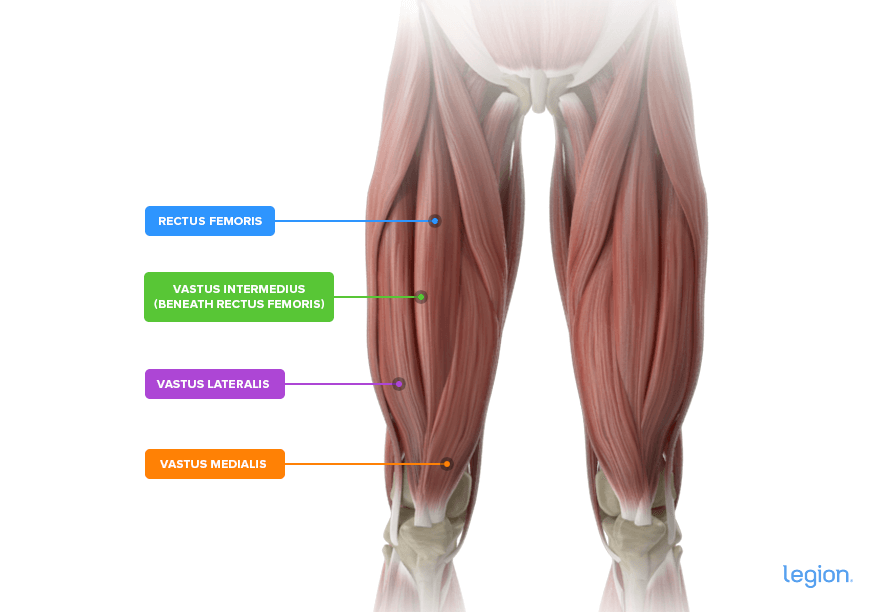
The three “vastus” muscles attach to the femur (thigh bone) and knee and are responsible for “extending” (straightening) the knee. Conversely, the rectus femoris attaches at the hip and knee, which means it extends the knee and “flexes” the hips (brings your knees closer to your chest).
Thus, to fully stretch the vastus lateralis, vastus medialis, and vastus intermedius, you must fully bend your knee. However, to fully stretch the rectus femoris, you must fully bend your knee while “extending” your hips (pushing your hips forward to create a straight line between your torso and thighs).
Most leg exercises, including the front, back, and Bulgarian split squat, involve bending the knees while extending the hips, but few involve bending the knees while the hips remain extended.
This means most leg exercises train the vastus muscles in a fully stretched position but don’t train the rectus femoris when fully lengthened. This is significant because studies show that training your muscles in a stretched position is important for maximizing growth.
In other words, most leg exercises effectively train the vastus muscles, but most don’t optimally stimulate the rectus femoris.
The sissy squat is different. It involves squatting with your hips fully extended, making it ideal for emphasizing the rectus femoris and rounding out your quad development.
(If you like training tips like this and want an even more in-depth guide to how you should train to build your best body ever, check out my fitness books for men and women, Bigger Leaner Stronger and Thinner Leaner Stronger.)
Sissy Squat: Muscles Worked
The sissy squat exercise trains all four muscles of the quadriceps:
- Vastus medialis
- Vastus lateralis
- Vastus intermedius
- Rectus femoris
Here’s how they look on your body:
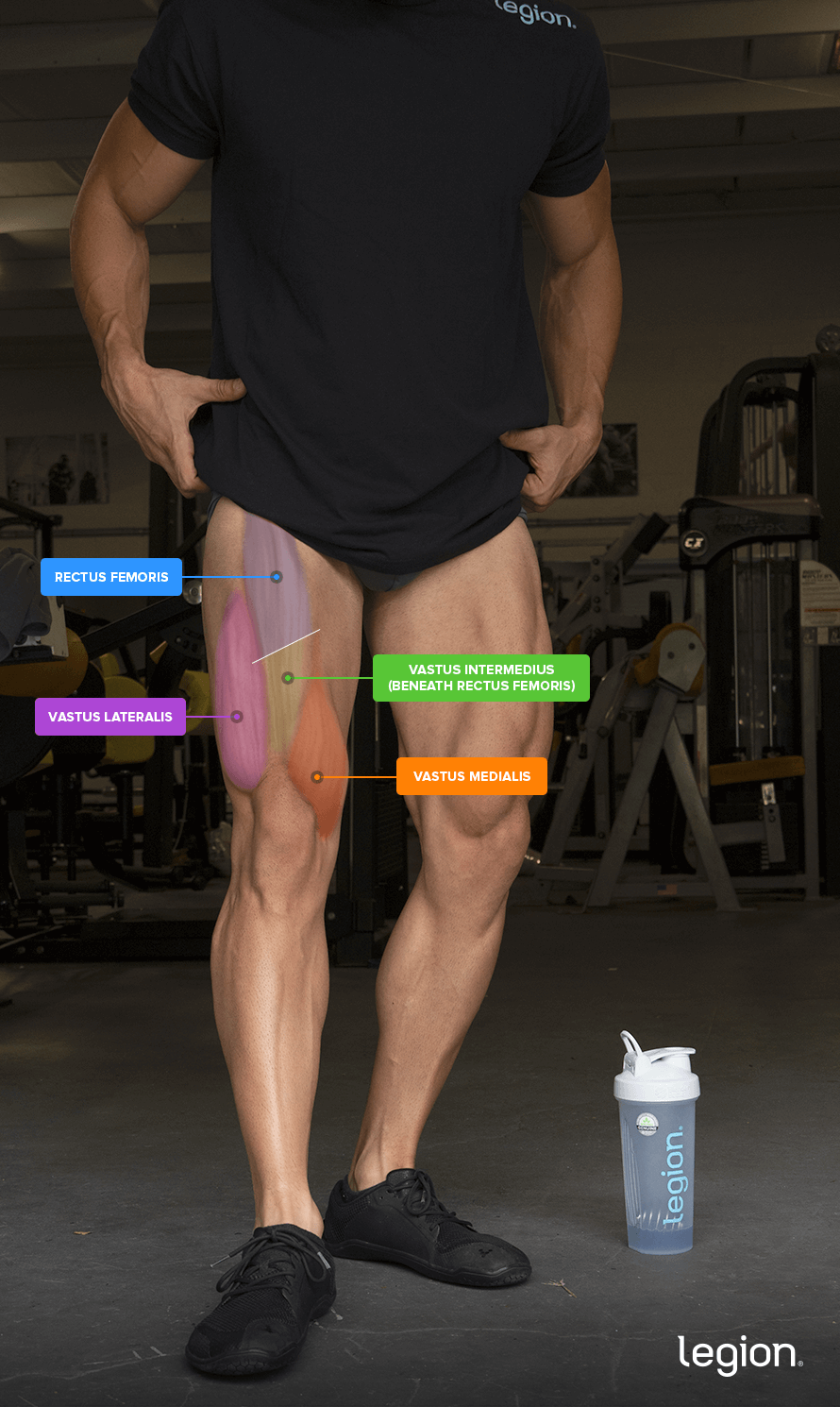
Sissy Squat: Form
The best way to learn how to do a sissy squat is to split the exercise into three parts: set up, descend, ascend.
1. Set Up
Stand with your feet shoulder-width apart and a sturdy object (such as a squat rack) 1-to-2 feet from your dominant side. Grab the object with your dominant hand between hip and chest height.
2. Descend
Flex your glutes as hard as possible, then bend your knees and allow them to move forward over your toes. As you descend, let your body lean backward and your heels come off the floor.
Continue descending as far as you comfortably can or until your glutes are 6-to-12 inches from your heels.
3. Ascend
Reverse the movement and return to the starting position by pushing your feet into the floor and straightening your knees. This is a mirror image of what you did during the “descent.”
As you ascend, ensure your hips remain fully extended so that your body forms a straight line from your head to your knees.
Here’s how it should look when you put it all together:
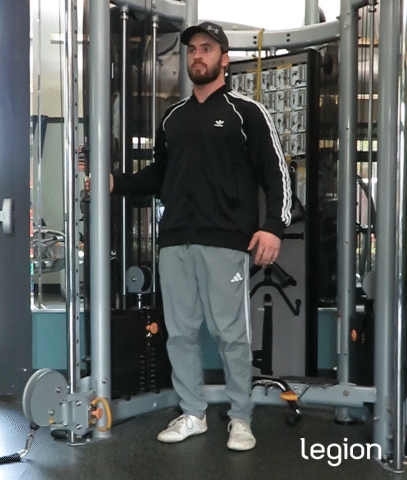
The Best Sissy Squat Alternatives
1. Kneeling Sissy Squat
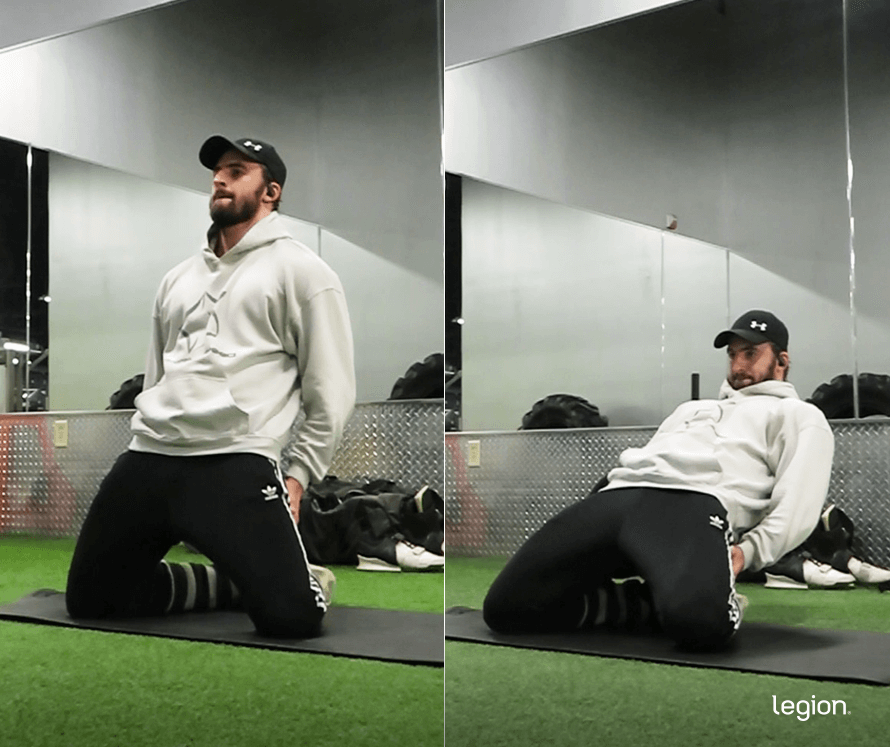
The kneeling sissy squat is an excellent variation if you’re new to sissy squatting because it allows you to strengthen the same muscles as the regular sissy squat from a kneeling position, which gives you a more stable base and minimizes the balance required to perform the exercise.
2. Banded Sissy Squat
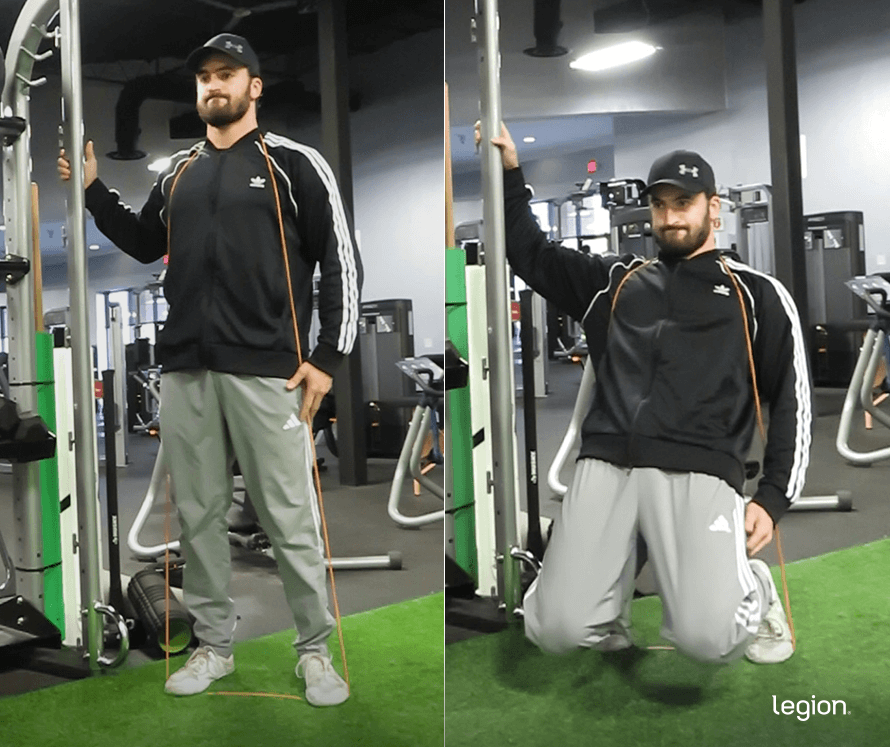
In the banded sissy squat, you stand on one end of a resistance band and wrap the other end behind your neck. This allows you to progressively overload the sissy squat when the bodyweight sissy squat becomes too easy, which is vital for gaining muscle and strength.
3. Smith Machine Sissy Squat
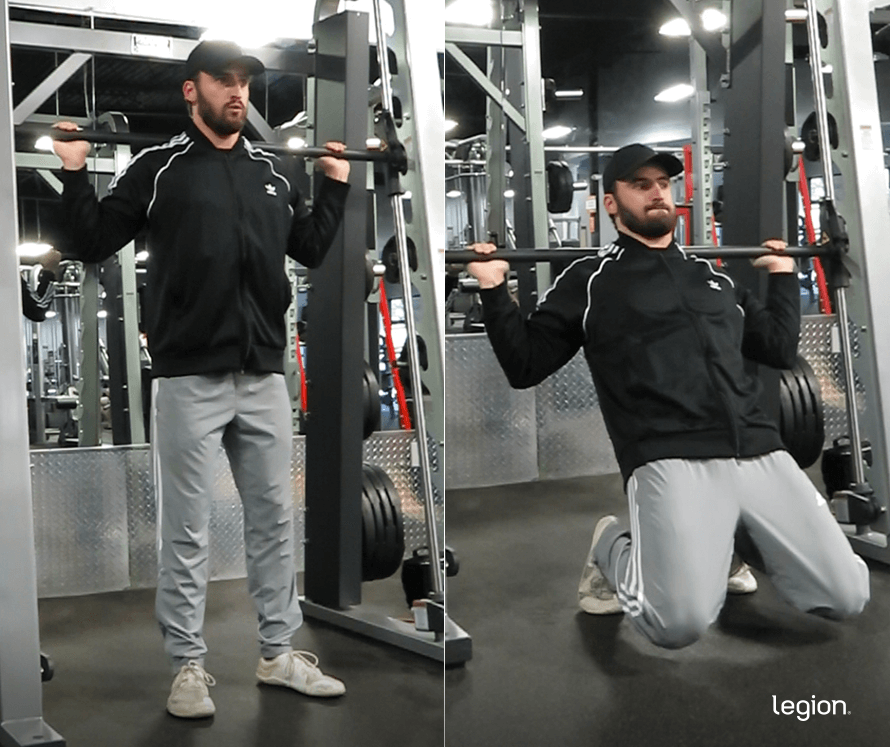
The Smith machine sissy squat requires less balance and coordination than the regular sissy squat, making it a workable variation for those who find the regular version unstable or awkward.
Using a Smith machine also makes adding weight to the sissy squat more straightforward, which is beneficial for advanced weightlifters who find the bodyweight version too easy.
4. Weighted Sissy Squat
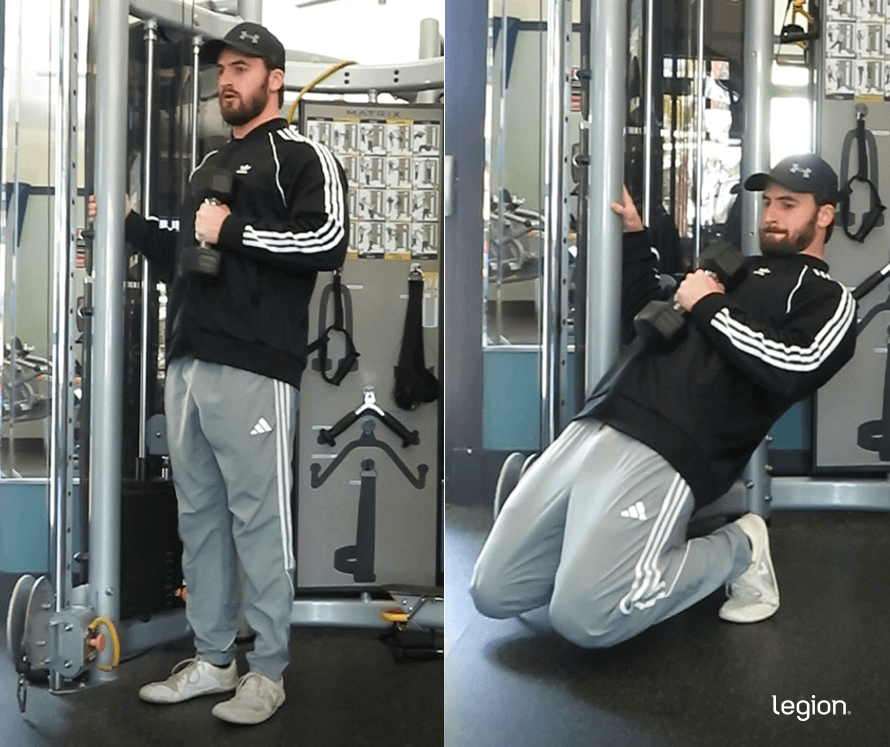
The main benefit of the weighted sissy squat over the bodyweight sissy squat is that it allows you to lift progressively more weight over time, which is important for gaining muscle and strength. That said, the weighted sissy squat is difficult to do correctly, which means it isn’t ideal for everyone, especially new weightlifters.
+ Scientific References
- Neumann DA. Kinesiology of the hip: A focus on muscular actions. Journal of Orthopaedic & Sports Physical Therapy. 2010;40(2):82-94. doi:https://doi.org/10.2519/jospt.2010.3025
- Maeo S, Huang M, Wu Y, et al. Greater Hamstrings Muscle Hypertrophy but Similar Damage Protection after Training at Long versus Short Muscle Lengths. Medicine & Science in Sports & Exercise. 2020;53(4):825-837. doi:https://doi.org/10.1249/mss.0000000000002523
- Pedrosa GF, Lima FV, Schoenfeld BJ, et al. Partial range of motion training elicits favorable improvements in muscular adaptations when carried out at long muscle lengths. European Journal of Sport Science. Published online May 23, 2021:1-11. doi:https://doi.org/10.1080/17461391.2021.1927199
- EARP JE, NEWTON RU, CORMIE P, BLAZEVICH AJ. Inhomogeneous Quadriceps Femoris Hypertrophy in Response to Strength and Power Training. Medicine & Science in Sports & Exercise. 2015;47(11):2389-2397. doi:https://doi.org/10.1249/mss.0000000000000669
- Kubo K, Ikebukuro T, Yata H. Effects of squat training with different depths on lower limb muscle volumes. European Journal of Applied Physiology. Published online June 22, 2019. doi:https://doi.org/10.1007/s00421-019-04181-y
You May Also Like
Our Most Popular Evidence-Based Articles
You don’t need supplements to build muscle, lose fat, and get healthy. But the right ones can help.
Take our 60-second quiz now to learn which supplements can help you achieve your fitness goals faster.
Sending…
Your free stuff is on the way!
Follow the Diet Plan that Helped Nikita Lose 15 Pounds in 3 Months
“I never thought getting in shape would be this simple! Everything just WORKS when you follow this plan.” And if he can do it, why not you?

Wait!
Want a Free Custom Meal Planning Tool?
Quickly calculate your calories, macros, and micros for losing fat, building muscle, and staying healthy.
Our “No Return Necessary”
Money-Back Guarantee
If you don’t like something of ours, guess what happens next?
No, we don’t request you deliver it to a PO box in the Gobi Desert by carrier pigeon. Nor do we ask you to fill a cursed inkwell with orc’s blood and demon saliva and then use it to complete reams of return forms written in ancient Cyrillic script.
We just . . . wait for it . . . give you your money back. Holy moo cows. And that means you can say “yes” now and decide later.
Free Worldwide Shipping & Returns
Many companies use shipping and handling fees to increase their profit margins, but here at Legion, we hate profits, so our shipping is free!
Okay, so we do dig on profits, but we also go in for happy customers, and free shipping works like gangbusters. So, if you live in the United States, your order ships free regardless of order size, if you live in the UK or Canada, your order ships free when it’s over $99, and if you live elsewhere, your order ships free when it’s over $199.
Also, if you don’t absolutely love our stuff for whatever reason, we don’t request you deliver it to a PO box in the Gobi Desert by carrier pigeon.
We just . . . wait for it . . . give you your money back. No returns. No forms. No nonsense. Holy moo cows.
That means you can say “yes” now and decide later. You really have nothing to lose.
Free Worldwide Shipping & Returns
Many companies use shipping and handling fees to increase their profit margins, but here at Legion, we hate profits, so our shipping is free!
Okay, so we do dig on profits, but we also go in for happy customers, and free shipping works like gangbusters. So, if you live in the UK or Canada, your order ships free when it’s over $99.
Why the restriction on international orders? Unfortunately, shipping abroad is very expensive, and if we didn’t require a minimum order size, we’d lose a lot of money. But! We’re also hustling to improve our international logistics and will be passing our savings along to our international customers.
Also, if you don’t absolutely love our stuff for whatever reason, we don’t request you deliver it to a PO box in the Gobi Desert by carrier pigeon.
We just . . . wait for it . . . give you your money back. No returns. No forms. No nonsense. Holy moo cows.
That means you can say “yes” now and decide later. You really have nothing to lose.
Free Worldwide Shipping & Returns
Many companies use shipping and handling fees to increase their profit margins, but here at Legion, we hate profits, so our shipping is free!
Okay, so we do dig on profits, but we also go in for happy customers, and free shipping works like gangbusters. So, if you’re outside the USA, your order ships free when it’s over $199.
Why the restriction on international orders? Unfortunately, shipping abroad is very expensive, and if we didn’t require a minimum order size, we’d lose a lot of money. But! We’re also hustling to improve our international logistics and will be passing our savings along to our international customers.
Also, if you don’t absolutely love our stuff for whatever reason, we don’t request you deliver it to a PO box in the Gobi Desert by carrier pigeon.
We just . . . wait for it . . . give you your money back. No returns. No forms. No nonsense. Holy moo cows.
That means you can say “yes” now and decide later. You really have nothing to lose.
Clinically Effective Ingredients & Doses
Many ingredients in supplements don’t have any scientifically validated benefits, and many ingredients that do are often underdosed to the point of irrelevance.
That’s why we only use the choice ingredients and precise doses shown to be effective in peer-reviewed scientific studies.
Clinically Effective Doses
You need more than great ingredients to make great products—you also need proper doses. That’s why we use the precise doses of ingredients shown to be effective in peer-reviewed scientific studies.
100% Natural Ingredients
“Natural” doesn’t always mean “better,” but in many cases, natural ingredients are superior to artificial ones for various reasons, including purity, safety, and efficacy.
That’s why all of our ingredients in all of our products come from plant and animal sources, including sweeteners, colors, and flavors.
Made in USA
If you want to ensure the supplements you’re swallowing every day are safe and effective, you want products produced in the USA.
That’s why all of our supplements are made in America in NSF-certified and FDA-inspected facilities that operate in accordance with the Current Good Manufacturing Practice (cGMP) regulations.
Lab Tested
Did you know that supplements can contain dangerously high levels of toxins like lead, arsenic, and cadmium?
That’s why we test every ingredient of every supplement we produce for heavy metals, microbes, allergens, and other contaminants and ensure they meet the strict purity standards set by the FDA.
Naturally Sweetened & Flavored
While artificial sweeteners may not be as dangerous as some people claim, studies suggest that regular consumption of these chemicals may indeed be harmful to our health.
That’s why all of our supplements are naturally sweetened and flavored and contain no artificial food dyes, fillers, or other unnecessary junk.
Science-Backed Ingredients
Many ingredients in supplements don’t have any scientifically validated benefits. That’s why we only use choice ingredients shown to be effective in peer-reviewed scientific studies.
No Chemical Junk
“Natural” doesn’t always mean “better,” but in many cases, natural ingredients are superior to artificial ones for various reasons, including purity, safety, and efficacy.
That’s why all of our ingredients in all of our products come from plant and animal sources, including sweeteners, colors, and flavors.




Split your entire online purchase into 4 interest-free payments, over 6 weeks with no impact to your credit.

25%
today
25%
2 weeks
25%
4 weeks
25%
6 weeks

Shop and add items to your cart as normal!

Choose Sezzle at Checkout! You’ll be redirected to Sezzle to Sign Up or Log In
to complete your order.

Your order will be shipped out right away* and your payments will be split up
over 6 weeks.
*shipping times subject to merchant shipping policy
Shop directory. Reschedule payments. Plus more!
Waiver and Release of Liability
In consideration of the services and/or products offered by Legion Athletics, Inc. (“Legion”) including, but not limited to, nutrition plans, exercise routines and coaching, and in addition to the payment of any fee or charge:
I knowingly and voluntarily enter into this waiver and release of liability and hereby waive any and all rights, claims or causes of action of any kind whatsoever arising out of my use of Legion’s services and/or products, and I hereby release and hold harmless Legion and its consultants, officers, contractors, agents, owners and employees from any and all responsibility, liability, cost and expenses, including for injuries, damages or disorders (physical, metabolic, or otherwise), resulting from my use of Legion’s services and/or products.
I understand that fitness activities including, but not limited to, strength, flexibility, and cardiovascular exercise, with or without the use of equipment, are potentially hazardous activities that involve a risk of injury and even death, and I am voluntarily participating in these activities and using equipment and machinery with knowledge of the risks involved. I hereby agree to assume and accept any and all risks of injury or death related to said fitness activities.
I understand Legion’s services and products are not meant to treat or manage any health conditions or circumstances, and I acknowledge that Legion has recommended I obtain a healthcare provider’s approval for my use of Legion’s services and/or products, through regular physical examination(s) and/or consultation. I acknowledge that I have obtained my healthcare provider’s approval or have decided to use Legion’s services and/or products without such approval and hereby assume all responsibility for my use of said services and/or products.
I understand that results from using Legion’s products and/or services are not guaranteed, and I agree to not hold Legion liable for any outcomes or lack thereof.
OUT OF STOCK
Security Check
Please click the checkbox below. We apologize for the inconvenience.
If you don’t absolutely love this product, just let us know, and we’ll give you a full refund on the spot. No forms or return necessary.
Analyzed for purity and potency in a state-of-the-art ISO 17025 accredited lab by Labdoor™, the gold standard of third-party lab testing.
Analyzed for purity and potency in a state-of-the-art ISO 17025 accredited lab, the gold standard of third-party lab testing.
This product doesn’t just “contain natural ingredients’’—every ingredient is naturally sourced from plants and animals. This product contains no artificial or synthetic substances of any kind.
Fact Checked
Our scientific review board of nutritionists, dietitians, molecular biologists, doctors, and other accredited experts is responsible for reviewing every article, podcast, and video we produce to ensure they’re evidence based, accurate, trustworthy, and current.
Thanks to their connections, credentials, and academic experience, this team of MDs, PhDs, and other professionals has access to a wealth of research published in the largest and most prestigious journals in the world.
This allows them to not only review individual studies but also analyze the overall weight of the evidence on any and all topics related to diet, exercise, supplementation, and more.
If you feel that any of our content is inaccurate, misleading, out-of-date, or anything less than factual, please let us know in the comments section of the article in question.
Evidence Based
We follow a detailed, rigorous, multi-step process to create content that meets the highest standards of clarity, practicality, and scientific integrity.
First, our research associates provide our editorial team with accurate, up-to-date, proven scientific evidence.
Then, our editorial team uses this research to draft articles and outlines for podcasts and videos.
Finally, our scientific review board reviews the content to ensure all key information and claims are backed by high-quality scientific research and explained simply and precisely.
If you feel that any of our content is inaccurate, misleading, out-of-date, or anything less than factual, please let us know in the comments section of the article in question.
[ad_2]
Source link



